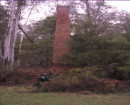LA MASCOTTE TREATMENT WORKS
SOPTHORPES TRACK AND LITTLE DART RIVER CORRYONG, TOWONG SHIRE
-
Add to tour
You must log in to do that.
-
Share
-
Shortlist place
You must log in to do that.
- Download report
Statement of Significance
The La Mascotte Gold Battery and Chlorination Works has been well scavenged but still retains a 60ft long roasting furnace. The furnace is constructed of rivetted iron panels and its interior still retains some of its brickwork. Associated with the furnace are numerous buried and partly buried machinery bits, and some ground level foundations. The La Mascotte Company erected the furnace (a mechanically rabbled one) on the site in 1897. The chlorination works proved unprofitable and was eventually closed in 1903.
The La Mascotte Gold Battery and Chlorination Works is of historical, scientific and archaeological importance to the State of Victoria.
The La Mascotte Gold Battery and Chlorination Works is historically and scientifically important as a characteristic and well preserved example of an important form of gold mining. When the greater part of the gold in some ores is contained in its pyritical contents, the gold is very difficult to extract. From the mid nineteenth century miners experimented with various metallurgical (or heat treatment) processes to unlock gold from heavily mineralised ore. Evidence of these metallurgical processes, such as the one carried out by the La Mascotte Company from 1897-1903, are extremely rare in the State of Victoria.
The La Mascotte Gold Battery and Chlorination Works is archaeologically important for its potential to yield artefacts and evidence which will be able to provide significant information about the technological history of gold mining.
[Source: Victorian Heritage Register]
-
-
LA MASCOTTE TREATMENT WORKS - History
Heritage Inventory History of Site:
The ten-head battery at the La Mascotte was driven by a 10-hp steam engine, the whole lot carted in by bullock from Wodonga. It took five bullock teams - 100 bullocks in all - to cart the machinery (weighing more than 18 tons) over the steep Mt Gibbo ('the Gibb'), at the head of the Nariel valley. Ore was conveyed to the battery by horse-sledge from the adit on the hill. Morrow writes that: 'Soon, benched out on the hill beside a huge spilling of mullock, was an array of rough-sawn, shingle-roofed huts, each with a sheet iron chimney.'
When the Government geologist visited the field in 1894, he found the Dark River ore 'not of a specially intractable character' and believed that it would be 'easily amenable to the ordinary processes for treatment of iron pyrites',i.e., chlorination. A company took up the challenge and erected a chlorination works on the field that same year. Ore was first roasted in a reverberatory furnace, then treated in a revolving barrel. But the furnace burned for less than three months then closed down, as a result of which most mines were also abandoned. The Mascotte Co. erected a new chlorination works on the same site (the old furnace having been pulled down) in 1897, comprising 'A large boiler, engines, a ten-head stamp mill, and a large mechanically rabbled furnace, constructed of iron and lined with fire bricks, together with vats and accessory plant'. This works, too, seemed doomed to early closure because of the excessive costs charged for the transportation of vital fluxes. The government responded with a grant to complete the road between Glendart and Cravensville, some 20 km north-west, which was connected by road with Tallangatta and beyond. It was expected that the improved road access would reduce carting prices by half and make chlorination viable at last. When the road was completed, chlorination resumed at the Glendart works, but poor returns forced its closure in 1903.Heritage Inventory Description
LA MASCOTTE TREATMENT WORKS - Heritage Inventory Description
Site comprises two benched level, lower level containing remains of a furnace, battery and boiler.
Heritage Inventory Significance: National Estate. The site has scientific significance because of the intactness and rarity of the furnace.
Heritage Inventory Key Components: Upper level - Measures 20 m x 10 m. Little is visible except for a scatter of bricks. Lower level - Measures approximately 50 m x 12 m and contains some foundations and the remains of plant including: Furnace - Remains of an iron mechanically-rabbled furnace, constructed of 3+-ft rivetted panels and measuring 60 ft x 4 ft, and standing 4 ft high. Along each side of the furnace is a row of small portals, each measuring 8 in. x 5 in. The furnace is partly obscured by vegetation and is half-full of rubble and ironwork, underneath which a lining of fire bricks may still exist. An iron screw mechanism runs under the furnace and is still visible at the front. A drain runs from the front of the furnace to a large rectangular brick vat, which is largely obscured by vegetation. It measures approximately 30 ft x 14 ft x 5ft deep. A flue running from the rear of the furnace has been covered by a collapsed stone retaining wall. Boiler and battery site - A battery and boiler, as indicated by the scatter of iron artefacts around the site, was probably located near the furnace. These are the remains of the 1897-1903 chlorination works, which replaced an earlier plant on the same site.
-
-
-
-
-
LA MASCOTTE GOLD BATTERY SITE AND CHLORINATION WORKS
 Victorian Heritage Register H1276
Victorian Heritage Register H1276 -
DART RIVER GOLD BATTERY SITE
 Victorian Heritage Register H1267
Victorian Heritage Register H1267 -
DART RIVER BATTERY
 Victorian Heritage Inventory
Victorian Heritage Inventory
-
-








